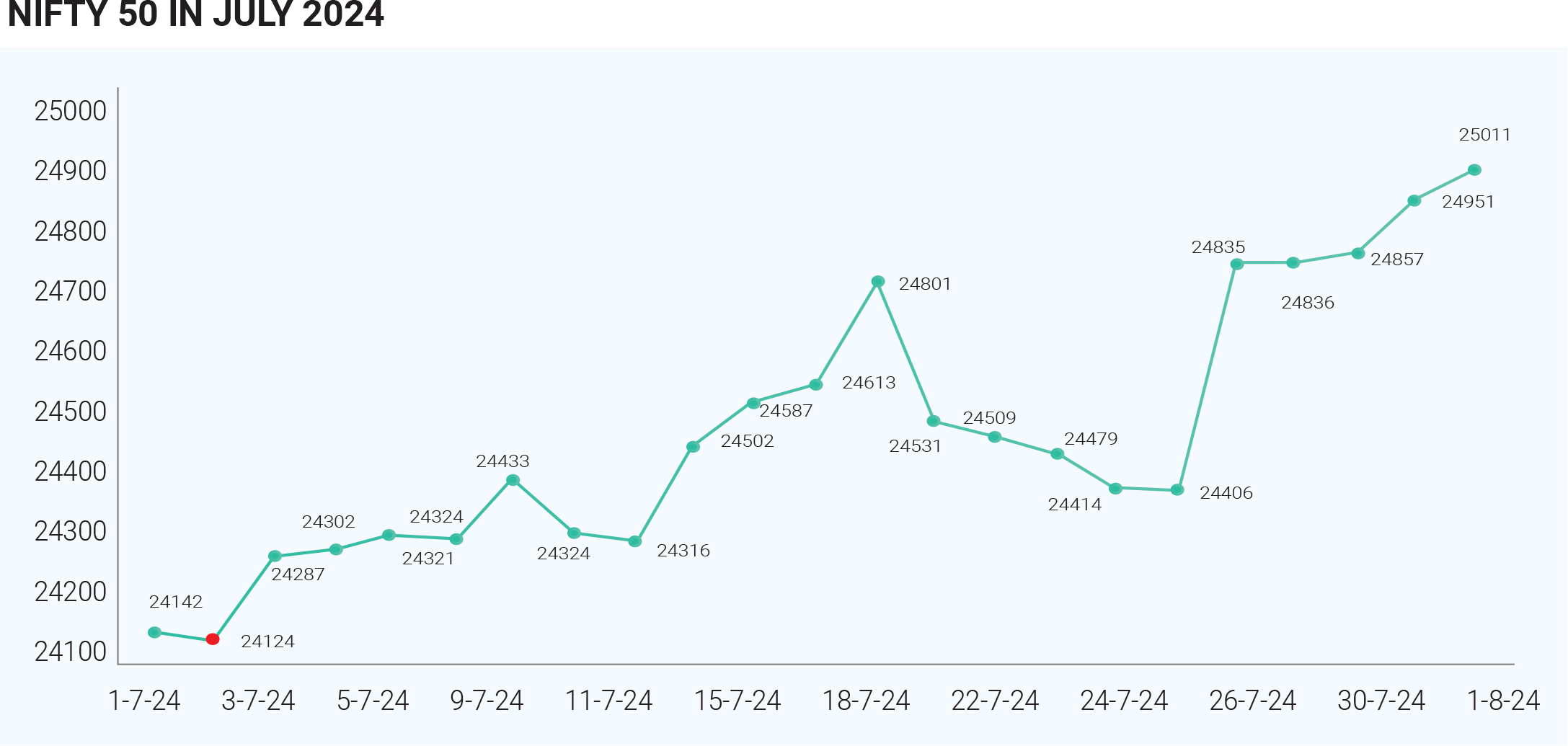July 2024 was a month of heightened volatility for Indian stock markets. The confluence of the budget's tax changes, and the income tax return deadline created uncertainty among investors. Uncertainty prevailed over the stock markets as investors were hesitant about how the new tax regime would affect their investments, leading to fluctuations in stock prices and overall market performance. Despite of that still markets in July 2024, both the BSE Sensex and NSE Nifty showed remarkable performance, reaching all-time highs by the end of the month. The BSE Sensex closed at 81,741.34 on July 31, 2024, reflecting a gain of 285.94 points or 0.35% for that day. Throughout the month, it saw significant increases, including a notable rise of 1,292.92 points or 1.62% on July 26, when it closed at 81,332.72. On the other hand, the Nifty 50 finished at 24,951.15 on July 31, up by 93.85 points or 0.38%. The Nifty also reached a peak of 24,999.75 during the month, closing at an all-time high of 24,834.85 on July 26, marking an increase of 428.75 points or 1.76% from the previous close. The IT sector thrived on anticipation of US Fed rate cuts, contributing to overall market positivity. Certain sectors, such as metals and IT, exhibited particularly strong performances, contributing to the overall gains in the Sensex and Nifty. But the markets also faced some volatility, with the Sensex falling over 500 points on July 10 due to changes in the government's ethanol blending policy and raw material cost volatility.


Foreign Institutional Investors (FIIs) exhibited a mixed
trend in their investments in the Indian stock markets
during July 2024. FIIs net bought shares worth Rs
25,108.69 crore until July 22, 2024, showing strong
buying interest in the initial part of the month. However,
in the next three trading sessions after the Union Budget
2024 was presented on July 23, FIIs resorted to
offloading positions and net sold shares worth Rs
10,711.70 crore. This brought down their net monthly
purchases to Rs 14,396.99 crore thus far in July, despite
still being the highest net inflow in a single month since
the last 13 months. The sudden reversal in FII sentiment
in late July was driven by changes in the treatment of
capital gains for listed, unlisted and compulsory
convertible debentures (CCDs) in the budget. The
increase in short-term capital gains tax from 15% to 20%
and long-term capital gains tax from 10% to 12.5%
impacted FII flows. In coming months, FIIs will assess
their stance in Indian markets depending on the factors
like corporate earnings growth, global central bank
policies, geopolitics and the upcoming US presidential
election.
The Indian rupee exhibited a mixed performance against
the US dollar in July 2024. The rupee traded in a narrow
range, a situation not seen in almost thirty years. This
stability was attributed to the Reserve Bank of India's
firm control over the currency's fluctuations, supported
by its substantial foreign exchange reserves. While the
rupee saw some volatility in early July, it largely traded in
a tight range for the rest of the month due to RBI
intervention and stable foreign inflows, with forecasts
suggesting a modest appreciation against the US dollar
in the coming months.
In July 2024, gold prices in India experienced notable
fluctuations, reflecting a mix of global economic factors
and domestic market dynamics. Domestic gold prices
dropped by nearly 5% on July 26, 2024, with 22-carat gold
prices falling to ₹67,700 per 10 grams from a high of
₹74,700 on July 17. This unprecedented drop marked the
sixth largest wealth erosion in Indian market history. The
major factors behind this erosion are attributed to the
Budget 2024 on July 23, announcing a cut in the basic
customs duty on gold, silver and platinum from 15% to
6% and also global gold price declines more than 1% due
to profit booking by investors as they awaited key US
economic data and clues on Fed rate cuts.
In July 2024, crude oil prices in India largely traded in a
range around ₹6,400 per barrel in July 2024, with global
factors like refinery throughputs, demand from China and
OPEC forecasts influencing the price movements. The
overall trend was one of stability compared to the sharp
fluctuations seen in some previous months.
The Indian stock market is poised for a turbulent August.
While positive factors like the anticipated Fed rate cut in
September and strong performance in IT, metals, and
energy sectors offer some support, several challenges
could dampen investor sentiment. Lacklustre Q1 FY25
earnings, coupled with potential profit-booking and
consolidation in global markets, may exert downward
pressure. Additionally, the rupee's depreciation against
the US dollar could trigger capital outflows. These factors
combined are likely to introduce volatility and create
headwinds for the Indian market in the coming month.
The Union Budget 2023 unveiled a comprehensive
package of reforms, social programs, and regulatory
changes aimed at propelling India's development. This
Budget introduced significant changes to India’s tax
landscape, with a particular focus on international
financial transactions. While the revised income tax slabs
garnered much attention, modifications to the Tax
Collected at Source (TCS) under the Liberalised
Remittance Scheme (LRS) also had a substantial impact
on individuals sending money abroad. Let's explore into
the world of foreign remittances and the recent changes
brought about by the Indian government.
WHAT IS LRS?
The Liberalised Remittance Scheme (LRS) is a framework
established by the Reserve Bank of India (RBI) that allows
Indian residents to remit a certain amount of money
abroad for various permissible transactions. The
Liberalised Remittance Scheme (LRS) is a great help to
the one who does international transactions.
KEY FEATURES OF LRS
• Remittance Limit: Under LRS, Indian residents
can remit up to $250,000 per financial year for various
purposes, including education, travel, medical treatment,
and investments abroad.
• Permissible Transactions: The remittances can
be used for various purposes such as: Education
expenses, Medical treatment, Travel, Investments in
foreign assets and, Gifts and donations
• No Restrictions on Frequency: There are no
restrictions on the number of transactions, but the total
amount remitted must not exceed the annual limit.
• Documentation: Individuals must provide
necessary documentation, including a Permanent
Account Number (PAN), to facilitate remittances.
WHAT IS TCS IN FOREIGN REMITTANCE TRANSACTIONS?
TCS, short for, Tax Collected at Source, is the type of
income tax collected by the seller of selected goods and
services from the buyer. In the context of Foreign
Remittance Transactions, this kind of tax can be collected
from sender when he sends money abroad. Here, it is
crucial to note that sending money doesn’t only mean
sending it to someone. It could even imply touring abroad,
shopping, investing abroad, purchasing assets, etc.
CHANGES PROPOSED IN BUDGET 2024
• For remittances under LRS, other than for
education and medical treatment, the TCS rate has been
reduced from 20% to nil for amounts up to ₹7 lakh per
financial year, effective retrospectively from July 1, 2023.
• For payments for overseas tour program
packages, the TCS rate has been reduced from 20% to 5%
for amounts up to ₹7 lakh per financial year, effective
retrospectively from July 1, 2023.
• A 20% TCS rate is applicable from October 1,
2023, for remittances under LRS (other than for education
and medical treatment) and payments for overseas tour
program packages exceeding ₹7 lakh in a financial year.
• International payments via debit card or Forex
card exceeding ₹7 lakh in a financial year are now subject
to LRS and a 20% TCS rate.
• International credit card payments have been
excluded from the ambit of LRS, effectively exempting
these transactions from TCS regulations.
• For educational expenses, there is no TCS on
foreign remittances below ₹7 lakh. For amounts above ₹7
lakh, TCS is 0.5% if the remittance is through a loan from
an approved financial institution, and 5% if not funded by
a loan.
• Any remittance for medical treatment above ₹7
lakh is subject to TCS at 5%.
• These changes aim to rationalise the TCS regime
for remittances under LRS, providing relief for lower-value
transactions while maintaining oversight for higher-value
remittances. The exclusion of international credit card
payments from LRS was a notable change in response to
practical challenges taxpayers face. LRS provides Indian
resident individuals with the flexibility to remit funds
abroad for various purposes, while adhering to the limits,
documentation requirements and tax implications set by
the regulations. Investors should be cautious to ensure
compliance with RBI guidelines.
Copyright © 2021 Fintso
